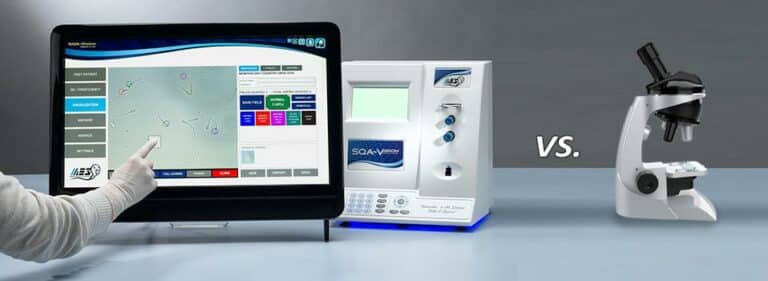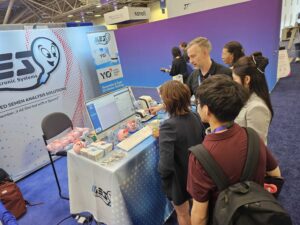Introduction
Laboratory managers in hospitals, free-standing labs, and other health centers face difficult decisions regarding the purchase of equipment and hiring and training of personnel. These decisions are made more difficult when managers must decide whether to advocate for the purchase of automated analyzers or to hire and train new employees.
There are risks and benefits associated with both equipment purchases and employee development. However, recent advances in many laboratory analytical devices have obviated the need for hiring and training technicians. This is particularly the case for laboratories that perform sperm analysis.
Semen analysis is notoriously subjective and non-standardized. For these reasons alone, training and retention of qualified technicians are challenging. However, there are several more reasons why your hospital or health center might consider investing in an automated semen analysis system.
The shortage of Laboratory Technicians and Clinical Laboratory Scientists
As long ago as the early 2000s, the US Department of Labor was projecting substantial workforce shortages for laboratory technicians. Every year, fewer individuals graduate from accredited training programs than are needed to fill laboratory positions. From 1983 to 1992, the number of graduating laboratory practitioners decreased by 50%. The capacity to train new personnel has also declined. As a result, there are substantially fewer training programs in 2021 than in the early 1990s. The problem is particularly acute in rural areas of the US; however, major cities in the US do not have training programs for medical laboratory technologists or medical technologists (e.g., Miami and Los Angeles).
Personnel turnover is a perennial problem. At the lowest point, some categories of laboratory technicians were turning over at a rate of 20%. Many laboratories rely on temporary staffing agencies to fill the demand. Temporary workers pose several problems for technology-intensive laboratories, not least the time and resources required for training.
Promising candidates for technical laboratory schools are often lured away by the promise of higher compensation in industry or other allied health careers. In 2002, the mean entry-level salary for a medical laboratory technician was $30,200. By contrast, first-year registered nurses were earning an average of $48,240. Starting physical therapists were averaging $59,130 per year, and pharmacists were making an average of $72,800.
Finally, many potential laboratory technicians considered the high levels of stress associated with laboratory work, to say nothing of possible exposure to pathogens, grueling working schedules, and absence of opportunities for advancement.
During the COVID-19 pandemic, the workforce problem became even more acute. Many of the technicians who were laid off when clinics closed in the early months of the pandemic did not return as the clinics opened, some because of monetary assistance provided by the Federal government, others because of fear of contagion, particularly in hospitals. Still, others took the opportunity to seek employment in safer environments.
Manual Semen Analysis by Trained Technicians
For laboratories lucky enough to attract technicians to perform sperm testing, several detailed steps must be taught and mastered before handling patient samples: initial macroscopic and microscopic examinations, sperm motility evaluations, progressive motility estimates, assessments of sperm vitality, sperm counting, and normal sperm morphology identification, to name only the routine functions.
There are also special tests such as measurement of indices of multiple sperm defects and pan leukocyte immunocytochemical staining. Finally, and most critically, ongoing proficiency, quality assurance, and quality control must be performed by staff personnel, tasks that are notoriously susceptible to error.
Automated Semen Analysis with Sperm Quality Analyzers
By contrast, automated semen analysis requires training the laboratory technician to use one device that performs all the necessary functions, saving training time while eliminating subjectivity and improving standardization. The cost-benefit analysis when comparing automated semen analysis devices with manual examinations is clear, and several well-designed studies demonstrate that the machines are better. In addition, semen quality analyzers consistently generate more highly standardized and reproducible results than human technicians performing manual semen analysis.
The ability of automated semen analyzers to interface with Laboratory Information Systems (LIS) and Electronic Medical Record Systems (EMR) also reduces errors associated with data entry and the calculation of sperm parameter values and results.
Why acquire an Automated Sperm Quality Analyzer for Semen Analysis?
The SQA-Vision Automated Semen Analyzer is a rapid and accurate tool that suits the needs of routine screening facilities, infertility specialists, and in-vitro fertilization (IVF) centers of excellence. The device runs eight different sample types to meet the testing requirements of any facility performing semen analysis or other types of sperm preparation and quality control.
The Vision performs a range of analyses. When activated, the FDA-approved device performs automated calibration and self-tests before displaying key reference parameters with shortcuts to daily maintenance checklists and service information. In other words, quality control comes first. In addition, service records are stored for future reference, and bi-annual proficiency testing through the College of American Pathologists (CAP) is available with extensive national peer group reporting.
To run tests, the SQA-Vision requires sample sizes of only 0.5 ml; however, there is a 0.25-ml option for short samples. There is also a 15 µl option for IVF clinics and sperm banks that cannot afford to waste any sperm.
Given the precision, accuracy, and reliability of automated semen analyzers, it becomes evident that human technicians cannot perform at the same level for equivalent lengths of time. Of course, the purchase of these devices does not eliminate the need for human operators. The automated analyzers remove the subjectivity from analyses. Still, the technician must use their talent and judgment in sample preparation and testing, then prepare reports appropriate for a specific clinic or application.
Conclusion
Automated Sperm Quality Analyzers are unlikely to replace all human expertise. On the contrary, automation frees up human capital to engage in their skills’ highest and best uses. Young people who previously would have considered careers as laboratory technicians may now invest their time and financial resources in acquiring rare and specialized skills and knowledge. They then leverage those skills to obtain better-paying jobs and contribute to their communities overall health and wealth.
For all these reasons, a laboratory manager should not lament the laboratory technician labor pool’s shrinkage or the closing of training programs and schools. On the contrary, the replacement of human technicians with machines and robots that perform their former jobs nearly flawlessly allows those individuals to expand their horizons further.
Finally, there is the bottom line to consider. Over time, the purchase of semen quality analyzers, including service contracts, promises to be far less expensive than hiring and training technicians, with equivalent or superior results in terms of output. Patients are the ultimate beneficiaries, and improved outcomes are the goals of all healthcare providers.




